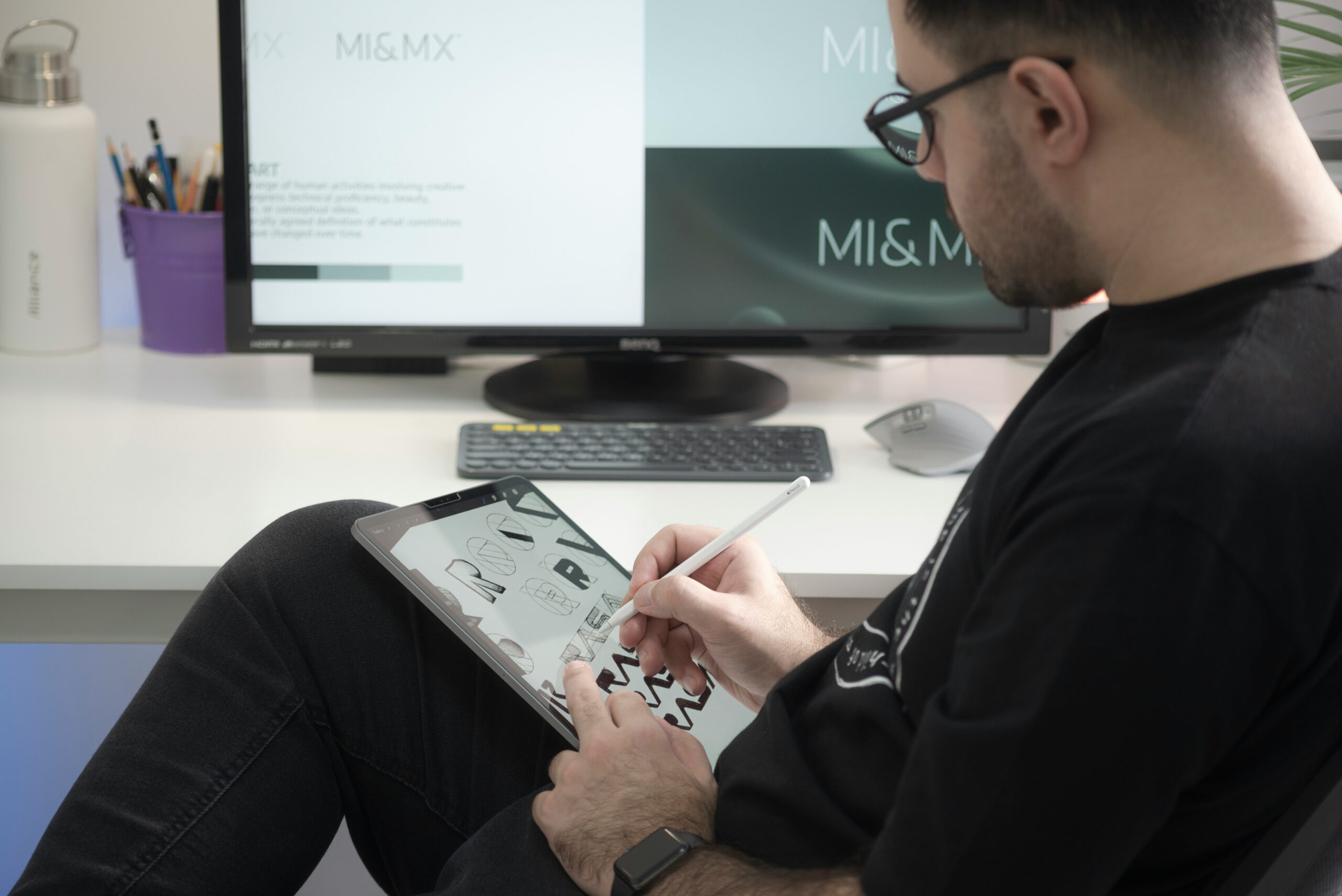Comprehensive Glossary for Screen Printing, Heat Press Transfers, Embroidery, and Promotional Items
When your business is in need of apparel or merchandise, navigating a new world full of opaque terminology can be frustrating. At Heart and Hook, we want to be as transparent as possible with our expertise so that you can use the lingo like a pro and ensure that your business receives a product that matches your vision.
With that goal in mind, this comprehensive glossary aims to demystify the terminology associated with screen printing, heat press transfers, embroidery, and promotional items.
Screen Printing
1. Screen Printing:
- A printing technique where a design is transferred through a mesh screen to an underlying layer, such as a T-shirt.
2. Mesh Count:
- The number of threads per inch on a screen; higher mesh counts result in finer details.
3. Squeegee:
- A tool used to push ink through the screen and onto the underlying layer
4. Plastisol Ink:
- A type of ink commonly used in screen printing that contains PVC particles suspended in a plasticizer.
5. Water Based Ink:
- Ink that uses water as a base, environmentally friendly, and suitable for soft fabrics.
6. Curing:
- The process of setting the ink onto the underlying layer using heat, ensuring durability.
7. Flash Cure:
- A brief heating of the ink between the printing of each color to prevent bleeding.
8. Spot Color:
- Printing using pre mixed colors rather than blending CMYK.
9. Halftone:
- A technique that creates the illusion of continuous tones by varying the size and spacing of dots.
10. Underbase:
- A layer of white ink printed on dark garments to enhance the vibrancy of colors.
11. Screen Printing Process:
Screen printing is a versatile and widely used method for transferring designs onto various surfaces, such as T-shirts, posters, and textiles. Here’s an in depth breakdown of the screen printing process:
- Design Preparation:
- Artwork Creation: Start with a digital or hand drawn design that represents what you want to print.
- Color Separation: If your design has multiple colors, separate each color into individual layers to create distinct screens for printing.
- Screen Preparation:
- Mesh Selection: Choose a screen made of fine mesh fabric. The mesh count affects the level of detail in the print, with higher counts providing finer details.
- Coating with Emulsion: Apply a light sensitive emulsion to the screen. When exposed to light with the separated design, the emulsion hardens, creating a stencil.
- Exposure and Developing:
- Exposure: Place the separated design on the coated screen and expose it to light. The areas covered by the design block the light, leaving the stencil on the screen.
- Rinsing: Wash the screen to remove the unhardened emulsion, revealing the stencil. This process creates open areas (where ink will pass through) and blocked areas (where ink is blocked).
- Exposure and Developing:
- Exposure: Place the separated design on the coated screen and expose it to light. The areas covered by the design block the light, leaving the stencil on the screen.
- Rinsing: Wash the screen to remove the unhardened emulsion, revealing the stencil. This process creates open areas (where ink will pass through) and blocked areas (where ink is blocked).
- Printing Setup:
- Alignment: Properly align the screens for multi color prints to ensure precise registration.
- Platen Setup: Position the material (e.g., T shirt) on a flat surface called a platen, securing it in place.
- Ink Application:
- Ink Mixing: Prepare the ink colors according to the design specifications.
- Loading the Screen: Apply ink to the top of the screen, spreading it evenly.
- Printing Process:
- Squeegee Action: Use a squeegee to press the ink through the open areas of the screen and onto the material below.
- Stroke Direction: Typically, the squeegee moves from the back of the screen to the front, forcing ink onto the material in a smooth and controlled manner.
- Repeat for Each Color: For multi color designs, repeat the process, allowing each color to dry between applications.
- Curing:
- Drying: After printing, allow the ink to dry partially to prevent smudging.
- Heat Setting: Use a conveyor dryer or heat press to cure the ink fully. This process ensures the ink bonds with the material, creating a durable and long lasting print.
- Cleanup:
- Screen Reclamation: Remove any remaining ink from the screen, and reclaim the screen by removing the hardened emulsion. This prepares the screen for future use.
- Quality Control:
- Inspecting Prints: Examine the final prints for consistency, color accuracy, and detail.
- Touch Ups: Address any imperfections or inconsistencies through touch ups or corrections.
- Packaging and Delivery:
- Folding and Packaging: Fold and package the printed materials according to client specifications.
- Delivery: Ship or deliver the finished products to the client or end user.
The screen printing process, with its meticulous steps and attention to detail, allows for the creation of vibrant and customized prints on a variety of surfaces, making it a popular choice for both artistic and commercial applications.
Regarding fabrice and construction of t-shirts, check out our article, Choosing the Perfect T Shirt: A Comprehensive Guide for Every Occasion within our resources section.
Heat Press Transfers
1. Heat Press:
- A machine that applies heat and pressure to transfer a design onto a substrate.
2. Transfer Paper:
- Paper coated with a special ink receptive layer for use in heat press transfers.
3. Sublimation:
- A process where heat transforms ink into a gas that permeates the substrate, creating vibrant and permanent designs.
4. Vinyl Transfer:
- Cutting designs from vinyl sheets and heat pressing them onto substrates.
5. Dye Sublimation:
- A process where sublimation inks are used to print designs onto a transfer paper, then heat pressed onto polyester based substrates.
6. Digital Transfer Printing:
- Printing designs onto transfer paper using a digital printer, then heat pressing onto the substrate.
7. Die Cutting:
- Cutting out shapes or designs from sheets of material, often vinyl, for heat press applications.
8. Pneumatic Press:
- A heat press with an air powered system for consistent pressure.
9. Peel:
- The action of removing the transfer paper or carrier sheet after heat pressing.
10. Hot Peel vs. Cold Peel:
- Hot peel involves removing the transfer paper immediately after pressing, while cold peel requires waiting for it to cool.
Embroidery
1. Embroidery:
- The art of decorating fabric with needle and thread, creating intricate designs.
2. Digitizing:
- The process of converting a design into a format readable by an embroidery machine.
3. Stabilizer:
- Material placed beneath or on top of the fabric during embroidery to prevent distortion.
4. Hooping:
- The process of stretching fabric taut and securing it in an embroidery hoop for accurate stitching.
5. Bobbin:
- A small spool that holds the lower thread in an embroidery machine.
6. Thread Count:
- The number of threads per inch in embroidery; higher counts result in finer details.
7. Fill Stitch:
- A stitching technique where an area is filled with closely spaced parallel lines.
8. Satin Stitch:
- A series of flat stitches used to create a smooth, satin-like surface.
9. Appliqué:
- The action of removing the transfer paper or carrier sheet after heat pressing.
10. Embroidery Digitizer:
- A professional who converts artwork into a digital embroidery file.
Promotional Items
1. Promotional Products:
- Branded items used for marketing and advertising purposes.
2. Promotional Apparel:
- Clothing items imprinted with logos or messages for promotional use.
3. Branding:
- The process of creating and establishing a brand image through consistent messaging and design.
4. Giveaways:
- Items distributed free of charge for promotional purposes.
5. Lanyard:
- A cord worn around the neck to hold identification cards, keys, or other small items.
6. Promotional USB Drive:
- A USB flash drive customized with a company logo for promotional giveaways.
7. Promotional Pens:
- Pens imprinted with a company’s logo or message for marketing purposes.
8. Trade Show Swag:
- Promotional items given away at trade shows to promote a brand or product.
9. Branded Merchandise:
- Items featuring a company’s logo or messaging for promotional purposes.
10. Corporate Gifts:
- Premium items given to clients, employees, or partners as a gesture of appreciation.
Heart and Hook Apparel, a Phoenix area, screen printing and embroidery company wants to educate and inform for stronger collaboration with our clients.


